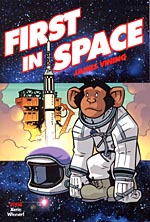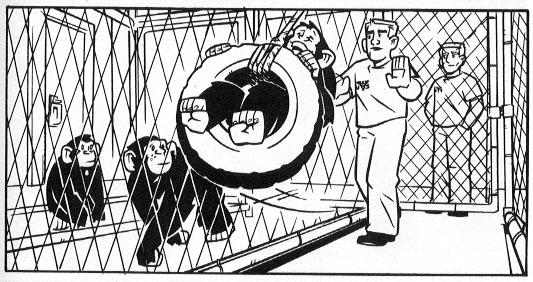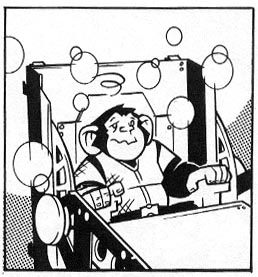 By James Vining
By James Vining
96 pages, black and white
Published by Oni Press
I have vague memories of seeing Ham at the National Zoo. Having moved to the DC area in 1974, trips there were very common, and the chimpanzees were no exception. I can sort of recall seeing him on display along with the mention that he was the first chimpanzee in space, and being fascinated by the idea that we’d sent animals into orbit. (I was distinctly less excited upon hearing about the fate of the Russian-sent dog Laika.) James Vining’s First in Space is a book that made me instantly wish it existed 30 years ago. It’s exactly what I would have wanted to read then, but fortunately it was also worth the wait.
At the Holloman Aeromedical Center in 1960, the United States was training a group of chimpanzees to go into sub-orbital spaceflight. If their missions succeeded, it would pave the way to eventually have humans journey into space. If not, the entire space program would need to be re-evaluated. That’s where the chimpanzee Chop-Chop Chang (nicknamed Ham) and his trainer, Airman Beacham, came into play. Only one chimpanzee could be the first in space—and that was something that was in Ham’s future.

What’s fun about Vining’s story is that while it’s absolutely based on true facts, there’s a lot of wiggle room for him to still tell the story as he wants. Certain facts are firmly set in stone and Vining uses those (Ham’s actual journey, the back-up monkey Minnie, where the training occurred) but the day-to-day events aren’t quite so copiously detailed. It gives Vining a lot of freedom in how he chose to bring Ham’s story to life. With that much latitude, it was nice that Vining didn’t go for the easy solution of villains at the Center not caring about the health and well-being of the chimps, or perhaps cruel and oppressive trainers working them to the bone. Instead people like Beacham and Doc Moseley still come across as nice and generally charming people. While accidents do sometimes happen, you can tell that they care about the chimpanzees and want them to survive. Vining’s also able to inject a little bit of tension into the story for those who don’t already know what happened, with the already-mentioned accidents as well as discussions on what these experiments might be doing to the chimpanzees in general. It’s a fun if perhaps slight story, and Vining makes it just the right length to keep you interested but never bore you.
 The art in First in Space is attractive, a blocky sort of style that still manages to be expressive and distinct. For a bunch of guys who are all wearing the same uniform shirts and pants in military haircuts, and standing next to a group of chimpanzees, I was pleased at how easy it was to tell characters apart with very few visual clues save facial features. When you can even tell some of the chimpanzees apart (especially Enos’s surly expressions) you know Vining has done a good job. Even better, though, is the sense of motion that Vining’s art gives to the reader. It’s the little things, like Beacham pushing Ham in a tire swing, or Ham leaping into Beacham’s arms that really come to life. It’s a very relaxed art style, and really attractive. It’s able to make things like Ham’s dreams come to life in a way that is easy on the eye and enjoyable to look at multiple times.
The art in First in Space is attractive, a blocky sort of style that still manages to be expressive and distinct. For a bunch of guys who are all wearing the same uniform shirts and pants in military haircuts, and standing next to a group of chimpanzees, I was pleased at how easy it was to tell characters apart with very few visual clues save facial features. When you can even tell some of the chimpanzees apart (especially Enos’s surly expressions) you know Vining has done a good job. Even better, though, is the sense of motion that Vining’s art gives to the reader. It’s the little things, like Beacham pushing Ham in a tire swing, or Ham leaping into Beacham’s arms that really come to life. It’s a very relaxed art style, and really attractive. It’s able to make things like Ham’s dreams come to life in a way that is easy on the eye and enjoyable to look at multiple times.
First in Space is the sort of book that it’s hard to not like. It’s easy to see why Vining was awarded a publishing grant from the Xeric Foundation (which he ended up not needing as it was then picked up by Oni Press). It’s a fun little read about a part of history that isn’t mentioned much these days. Vining is absolutely a talent to keep an eye on; whatever he’s going to work on next, I’ll definitely read.
Purchase Links:
